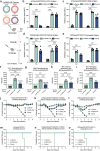Improved influenza vaccine responses after expression of multiple viral glycoproteins from a single mRNA
- PMID: 39379405
- PMCID: PMC11461824
- DOI: 10.1038/s41467-024-52940-z
Improved influenza vaccine responses after expression of multiple viral glycoproteins from a single mRNA
Abstract
Influenza viruses cause substantial morbidity and mortality every year despite seasonal vaccination. mRNA-based vaccines have the potential to elicit more protective immune responses, but for maximal breadth and durability, it is desirable to deliver both the viral hemagglutinin and neuraminidase glycoproteins. Delivering multiple antigens individually, however, complicates manufacturing and increases cost, thus it would be beneficial to express both proteins from a single mRNA. Here, we develop an mRNA genetic configuration that allows the simultaneous expression of unmodified, full-length NA and HA proteins from a single open reading frame. We apply this approach to glycoproteins from contemporary influenza A and B viruses and, after vaccination, observe high levels of functional antibodies and protection from disease in female mouse and male ferret challenge models. This approach may further efforts to utilize mRNA technology to improve seasonal vaccine efficacy by efficiently delivering multiple viral antigens simultaneously and in their native state.
© 2024. The Author(s).
Conflict of interest statement
Duke University has filed for protection of intellectual property related to the vaccine approach described in this manuscript on behalf of N.S.H. Y.T. is an officer with Acuitas Therapeutics, a company dedicated to the development of lipid nanoparticulate nucleic acid delivery systems for therapeutic and other applications. Y.T. is named on patents describing uses of modified mRNA LNPs. D.W. is a coinventor on patents that describe the use of nucleoside-modified mRNA as a platform to deliver therapeutic proteins or vaccines. The remaining authors declare no competing interests.
Figures





References
-
- Thompson, W. W. et al. Influenza-associated hospitalizations in the United States. JAMA292, 1333–1340 (2004). - PubMed
-
- Prevention, C.f.D.C.a. Preliminary Estimated Influenza Illnesses, Medical Visits, Hospitalizations, and Deaths in the United States—2022–2023 Influenza Season. 2024 (2023).
-
- Putri, W., Muscatello, D. J., Stockwell, M. S. & Newall, A. T. Economic burden of seasonal influenza in the United States. Vaccine36, 3960–3966 (2018). - PubMed
Publication types
MeSH terms
Substances
Grants and funding
LinkOut - more resources
Full Text Sources
Medical

